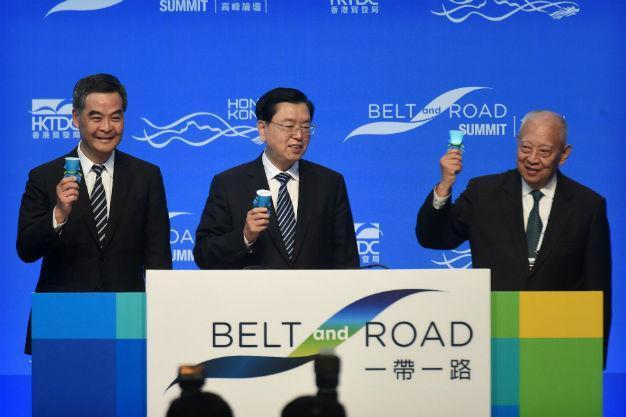China looking for brave new trade corridors
Ali Kayalar – HONG KONG

AFP photo
Just days after China marked the 50th anniversary of Mao Zedong’s Cultural Revolution, a movement to wipe “capitalist elements” out of the country, Beijing set further goals on May 18 for its multi-billion-dollar “One Belt, One Road” initiative, with Hong Kong sitting at the heart of the plans that would affect around 60 countries, including perhaps Turkey.“China is the initiator but this is not a one-man show,” said Zhang Dejiang, chairman of the Standing Committee of the National People’s Congress and the vice chairman of the National Security Commission of China, also known as the “third man” of the world’s second largest economy, during an opening speech at the Belt and Road Summit in Hong Kong.
“The Belt and Road are not private exclusive roads but wide and open avenues for all of us,” he said at the summit held under very strict security measures, adding that some 30 international agreements had been signed with the countries on the routes defined by China. Another deal with Indonesia was signed on May 18. However, Beijing still needs to convince more countries to build its planned network, which might make it an even stronger regional power if realized.
Six corridors
“It consists of six economic collaboration routes,” said Tommy Lui, the advisory board member of the Hong Kong Trade Development Council, who is also the Southern China director of Li & Fung, an arm of leading logistics company Fung, while addressing a group of visiting journalists.
The first of these corridors is the China-Russia-Mongolia route.
Authorities said Mongolia has played an important role in negotiations and that this will help in carrying goods produced in the northern parts of China to Europe faster than first taking them to Hong Kong before a long sea route if it connects to another projected corridor, the Eurasia Bridge. These two trade channels might cultivate Russia-China ties further.
Another route is the China-Central and East Asia corridor. Authorities said this would help Central Asian countries find trade partners, while it will also be important in terms of the mineral richness of the region.
The projected China-Indochina Peninsula corridor offers several Chinese production centers a shortcut to the ocean, while it may also help new industries emerge on its way.
But the most serious plan for Beijing to reach the ocean closer to Western maritime routes is the China-Pakistan corridor, which is also the most mature phase of the plan. China has already built oil refineries in the unrest-stricken country. The Pakistani army is in charge of protecting the facilities.
The last corridor is the the India-Bangladesh-Myanmar route, where China may find a cheaper workforce in exchange for marketing these countries’ goods.
Hong Kong the ‘super connector’
C.Y. Leung, the chief executive of the Hong Kong Special Administrative Region, said Hong Kong was a major link between mainland China and the rest of the world.
“In areas such as finance, investment and professional technology, Hong Kong’s unique super connector role can bring together the strengths of the Belt and Road economies,” he said.
China has already dedicated $40 billion to a Silk Road Fund, and the program was the driving force behind the establishment of the $50 billion Asian Infrastructure Investment Bank. However, the total investment amount remains vague since the initiative is only beginning to take shape.
Zhang praised the efforts with historic references to the ancient Silk Road.
“From the Yellow River to the Ganges, from the Nile to the blue Mediterranean, the flowers of ancient civilizations have bloomed in the course of mutual learning and become the shared memory of countries along the routes,” he said.
The idea of reviving the historic Silk Road is nothing new for China, but the latest shape of the initiative mirrors Beijing’s future projections that go far beyond logistics. Goals include building an Asian bond market and improving the use of the Chinese currency, the renminbi.
“Belt and Road” countries account for more than 60 percent of the world’s population, producing more than 30 percent of the world’s merchandise trade and 30 percent of the world’s GDP.
However, the honorary guests of the summit remained limited to a few countries such as Indonesia, Malaysia, Belarus and United Arab Emirates.
No Turkish officials were listed among the speakers, showing that Ankara, which once expressed its interest in the so-called Shanghai Five, might still be cautious about the Chinese initiative.
















